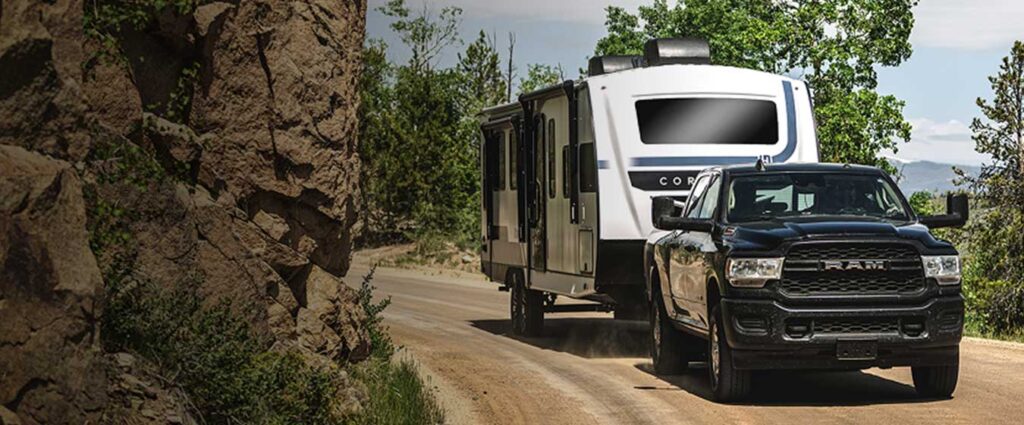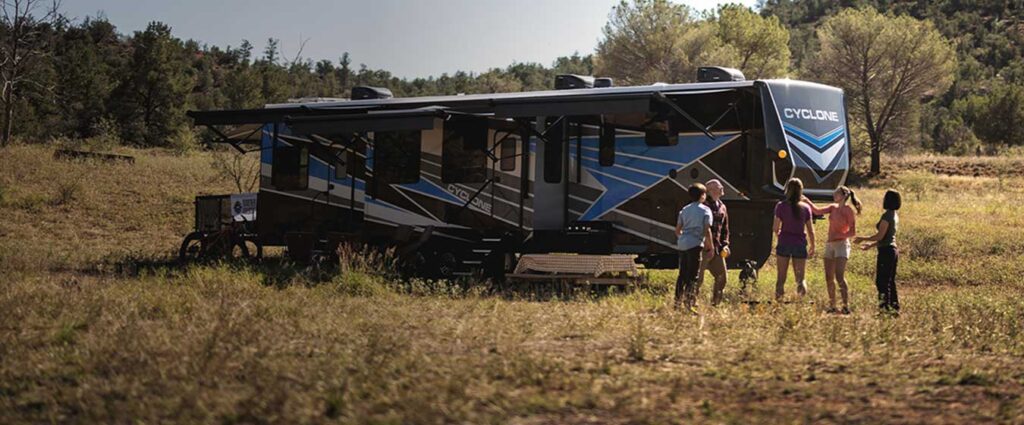Some of the best features in modern RVs are slide-outs. With the push of a button or the quick crank of your hand, you can expand your indoor living space, giving you more room to move, sleep additional guests, or host movie nights. And when RV slides are functioning properly, they’re easy to take for granted. But when something goes wrong, it can be a major headache, requiring professional help to fix and limiting your square footage.
So the best way to ensure your RV slides function properly is to keep on top of regular maintenance. With a few minutes of effort weekly, monthly, or every time you move campsites, you can keep your slides in great shape for years to come. And although they can seem like complicated mechanisms, keeping them well-maintained is simple – and we’ll walk you through it.

Get Familiar with Your RV Slides
Different RVs have different slide systems. Newer RVs most often use electric or hydraulic slides to minimize the work needed to get you set up at a campsite. But some RVs use manual slides, which require a bit of elbow grease to get set up. So the first step in slide-out maintenance is to get familiar with your slide system, which should be explained in detail in your owner’s manual, along with how to operate it correctly.
Slides also come in various constructions. Electric slide-outs often use a motor connected to a worm gear. They tend to be lighter than a hydraulic system and are often used on smaller, lighter-weight RVs. Hydraulic slide-outs can handle larger, heavier slides, which makes them great on more deluxe fifth-wheel models, for example. There are also rack and pinion slides, which are very common and affordable, and allow you to have flush floors and taller ceilings. And finally, cable slides are on the more expensive side, but can support big, heavy slides, offer flush floors, and are among the most reliable of all the slide mechanisms.

You don’t need to have an engineering degree to keep your slides in top shape. Just read up on which system your particular RV uses and get familiar with how it operates. There are tons of blogs, diagrams, videos, etc., online that can help demystify how each system works while explaining them in simple, easy-to-understand language. And that can make a huge difference in your ability to take care of your slides.
Maintaining Electric Slides
The motor that powers your slides uses a decent amount of electricity, so always make sure your battery is fully charged or that you’re plugged into shore power before you engage your slides. A circuit board controls the slide motor, with a fuse dedicated to supplying power to the slide. When you’re performing regular slide maintenance, check the electrical connections to make sure they’re secure, and give the circuit board a quick visual inspection for any damage. If any wires are hanging near moving parts, secure them out of the way with electrical tape. Then operate your electric slides and listen for anything out of the ordinary – grinding, crunching, or sounds that the motor is working harder than usual. The slide should extend without any unusual friction or jerking.
Maintaining Hydraulic Slides
Hydraulic slide systems include hydraulic fluid reservoirs, pressurized lines, and fittings to extend larger, heavier slides. To maintain hydraulic slides, check all the lines for any leaks or damage. Fittings are a common area where leaks can occur, so be sure to spend time inspecting everything carefully. Leaks are easier to spot on clean lines and fittings, so make sure to keep them clean and free from dirt, dust, and debris to better see when things go wrong.
Keep RV Slides Clean
Because slides extend part of the coach outward and into the elements, they can attract dirt, bugs, leaves, and other debris more easily than other parts of your coach. Always make sure you’re gently cleaning the tops, sides, and bottoms of your slides every time you set up or take down your campsite because foreign objects can harm your paneling, seals, and slide mechanisms. All you need is a soft broom or a leaf blower to clean your slides, most of the time. If you’ve unwittingly parked under a tree that drops a lot of sticky sap or pollen, RV roof cleaner products can help you get the gunk off without breaking your back scrubbing. Just make sure any cleaning products you use are specifically designed for RV surfaces, or you could wind up damaging the materials your RV is made from.

Lubricate, Lubricate, Lubricate
Wherever you have mechanical parts that move against each other, you need lubrication. Too much friction creates unnecessary wear and tear, but keeping slides lubricated is simple. Lubricate your rails and gears with a high-quality lubricant that’s formulated to prevent rust and attract less dirt and grime than other varieties. Keeping your components lubricated will also help waterproof them, which extends the life of your slides by protecting them against corrosion. Before you lubricate your slides, give them a quick once over with a wet rag soaked in soapy water to help remove any gunk that might affect how they operate. And don’t over-lubricate your slides – just follow the manufacturer guidelines as a best practice.
You’ll also want to lubricate your slide-out seals. Frequent exposure to the outdoors and sunshine can make them dry out and crack, which results in tearing and moisture seeping into a slide’s inner workings. Give them a quick wash as well and keep them moisturized with a rubber seal lubricant. If your slide seals are already damaged, it’s not difficult to buy replacement seals and install them yourself. In this case, an ounce of prevention will save you a huge headache down the road.

Consequences of Poor RV Slide Maintenance
Maybe you’re feeling like taking a few shortcuts on your slide maintenance in favor of getting on the road a little faster or getting it put away for winter a little quicker. It might not seem like a huge deal at the time, but failing to take care of your RV slides can have big consequences.
For one, it can cause your slides to extend or retract unevenly, causing unnecessary wear on slide components and making your slides crooked when extended. Dirty slide mechanisms can damage components over time, requiring more expensive repairs down the road than if you had just mixed up a bucket of soapy water and spent five minutes cleaning and lubricating every time you went camping.
Worst Case Scenario
But the absolute worst-case scenario is getting stuck somewhere with slides that won’t retract. You cannot drive or tow an RV with extended slides, which means you’re effectively trapped wherever you are until you can find a repair technician to come to you. If you tend to camp in well-traveled areas with lots of RVers, this may not be a big deal. You might be able to find someone at a larger campground to help you get it back in, or there may be service people ready to drive out to your campsite at a moment’s notice.
But what if you prefer to camp off the grid or in areas that are further away from major metropolitan areas? It might be harder to find assistance in those cases, leaving you stranded and frustrated while you wait for assistance. If that’s not a trip-ruiner, we don’t know what is. That’s why we recommend staying on top of slide maintenance before issues occur, so you can have the best possible vacation with the people you love spending time with.
So there you have it, campers! With these tips and tricks, your RV slide-outs will be well-maintained and working great for years to come. Once you integrate these tasks into your maintenance routine, it shouldn’t take you more than a few minutes to keep everything in top shape. A little bit of prevention can save you a whole lot of pain and annoyance down the road, so you can focus on the things that matter – fresh air, big adventures, and memories to last a lifetime. Safe travels!







